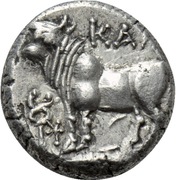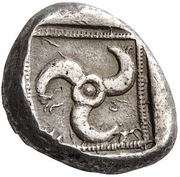Ancient Greek coins
The ancient Greeks are credited with inventing democracy, a language that largely remains unchanged for over 3000 years, and metal coinage as we know it today. From ores taken from ancient mines in the Mediterranean; copper, electrum, silver and gold all became small tokens of intrinsic value that were used in trade all over the ancient world. At the time, there were over 1000 Greek city-states, many of which issued coinage.
Uniformity in size and weight made it easier to establish denominations to ease trade. Payment for goods and labor could be standardized. In trade, conversion to foreign currencies also became easier and some coins like the Athenian tetradrachm were accepted directly as far away as the middle east and India.
City-states often took on a favorite mythological creature, god or animal mascot: the octopus of Sicily, the rosebud of Rhodes, and – arguably the most popular – the owl of Athens. Animals implying strength like lions, bulls, and eagles were also very popular. Zeus, Athena, Pegasus and many others played a starring role for several city-states.
Today prices vary from hundreds dollars if not many thousands for quality silver, gold, or electrum specimens, to only a few dollars for entry-level 2500-year-old bronzes. There is accessibility for all in this hobby. So get immersed in history and take a journey into the birth of coinage by exploring Greek coins.

Sicily 
-
Abakainon

-
Adranon

-
Agyrion

-
Aitna

-
Akragas

- Alaisa Aitnaia
-
Alaisa Archonidea

-
Alontion

-
Amestratos

-
Enna

-
Entella

-
Eryx

-
Galaria

-
Gela

-
Herbessos

-
Himera

- Hybla Megala
-
Iaetia

-
Kainon

-
Kalakte

-
Kamarina

-
Katane

-
Kentoripai

-
Kephaloidion

- Kimissa
- Kronia
-
Leontini

-
Lipara

-
Lopadusa

-
Mamertinoi

-
Menainon

-
Messana

-
Morgantina

-
Motya

-
Mytistratos

-
Nakone

-
Naxos

-
Petra

-
Piakos

-
Segesta

-
Selinos

-
Silerae

-
Stiela

-
Syracuse

-
Tauromenion

-
Thermai Himerensis

-
Tyndaris

- Uncertain Sicilian city

Thessaly 
- Ainianes
-
Atrax

-
Demetrias

- Dia
- Ekkarra
- Eurea
-
Eurymenai

-
Gomphoi / Philippopolis

-
Gonnos

-
Gyrton

-
Halos

-
Herakleia Trachinia

-
Homolion

-
Iolkos

-
Kierion

-
Krannon

-
Lamia

-
Larissa

-
Larissa Kremaste

-
Magnetes

-
Meliboia

-
Melitaia

-
Methylion

-
Metropolis

-
Mopsion

-
Oitaioi

-
Olosson

-
Orthe

-
Pagasai

-
Peirasia

-
Pelinna

- Perrhaiboi
-
Peumata

-
Phakion

-
Phalanna

-
Phaloria

-
Pharkadon

-
Pharsalos

-
Pherai

-
Proerna

-
Rhizos

-
Skotoussa

-
Thebai

- Thessalian League
-
Trikka

-
Tripolis




































































